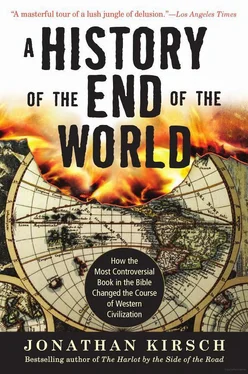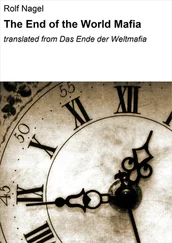Anxious and gullible Christians in the backwater of Asia Minor were not the only ones to fall under the spell of Montanus and his prophetesses. The most famous convert to Montanism was Tertullian (ca. 160–ca. 220), a fiery theologian of the early church in Carthage, who was convinced that he, too, would see the same remarkable sights with his own eyes. Tertullian writes credulously of reports from soldiers stationed in the Roman province of Palestine who claimed to have seen the spires and towers of a city hovering above the horizon at dawn—surely an early sighting of the celestial Jerusalem! And Tertullian’s anticipation of the final day of judgment betrays the same longing for revenge that is so prominently featured in the book of Revelation.
“How vast a spectacle then will burst upon the eye!” enthuses Tertullian, who predicts that the Roman governors who persecuted the Christians will suffer “in fires fiercer than those with which, in the days of their pride, they raged against the followers of Christ.” 15
Nor were the Montanists the only self-styled prophets who stoked the anxiety and anticipation of the Christian populace. A prophetess at work elsewhere in Asia Minor in the second century, for example, urged the men and women of Cappadocia to abandon their homes and make their way en masse to Jerusalem to greet Jesus Christ at the Second Coming. And a visionary named Judah, following the example of Revelation by reinterpreting the book of Daniel for himself, assured his fellow Christians in Alexandria that the Antichrist was at hand—a claim that, according to revered church historian Eusebius (263–339), was taken seriously only because a wave of persecution had “unsettled the popular mind.” 16
Then, too, Prisca and Maximilla were not the first or only women in early Christianity who believed themselves to be filled with the prophetic spirit. Indeed, the prophetess whom John calls “Jezebel” was an even earlier example of the same phenomenon. But the church authorities, like the author of Revelation himself, were especially prone to dismiss as a false prophet any self-styled seer who happened to be of the wrong gender. Against every effort of the organized church to suppress these visionary women, however, they have not been wholly erased from history, and we will meet them again and again in these pages. “What we hear of them, we hear from their sworn enemies,” feminist Bible scholar Mary T. Malone points out. “We hear enough, however, to be assured that many women, in many different parts of Christianity, still sought access to teaching, preaching and priestly roles.” 17
Paradoxically, the fact that Montanus and other doomsayers were demonstrably wrong in their predictions did not really seem to matter to the true believers among their followers—another phenomenon that we will encounter repeatedly in the history of the end of the world. Indeed, the failure of the New Jerusalem to descend at Pepuza only gave the Montanists “a new life and form,” according to one Catholic historian, “as a kind of Christianity of the elite, whom no other authority guided in their new life but the Holy Spirit working directly upon them.” 18After all, if John had been singled out by God to receive the remarkable visions that are recorded in Revelation, the same divine gift might be bestowed on others who came after him—and perhaps they would succeed where he had apparently failed in discerning the divine master plan for the end of the world.
And so, precisely because some church authorities feared what might boil up out of the overstimulated imaginations of the readers and hearers of Revelation, the adversaries of New Prophecy sought to discredit the book of Revelation itself. They argued that it was not actually the work of St. John the Evangelist; rather, they attributed its authorship to a man called Cerinthus, who had been declared a heretic and a sexual outlaw because he supposedly envisioned Christ’s thousand-year reign on earth as an opportunity for the “saints” to indulge themselves in “unlimited gluttony and lechery at banquets, drinking-bouts, and wedding feasts.” 19By denying that Revelation is a work of Holy Writ, the enemies of Montanus sought to strike an oblique blow at the charismatic but uncredentialed prophet, his little coven of amateur prophetesses, and all of their ardent followers.
But something more than the antics and excesses of Montanus and Cerinthus were at stake in the campaign against the canonization of the book of Revelation. Freelance prophets, male or female, were regarded by the high clergy as a grave threat to theological law and order. Since Revelation, then as now, seems to be the “text of choice” for visionaries and ecstatics—and, indeed, since it seems to sanction their febrile dreams and bizarre visions—the text itself is often considered suspect. 20For some of the sterner Christian authorities, then, cutting Revelation out of the Bible was like cutting out a dangerous cancer.
Revelation posed another awkward problem for the early Christian church as it struggled to find a way to survive in pagan Rome. The Roman emperors in Revelation are likened to demonic beasts who have seated themselves on the throne of the Devil. The richness and splendor of the Hellenistic way of life are denounced as “abominations and impurities.” 21Any Christian who makes his or her peace with the status quo of imperial Rome is condemned for trafficking in “the deep things of Satan.” 22Precisely because John is an uncompromising culture warrior whose sworn enemy is Roman civilization itself, his writings were an embarrassment to any Christian who sought to win friends and influence people in the Roman Empire.
Elsewhere in the New Testament, in fact, the authors are much more accommodating toward Rome. An unmistakable “spin” in the Gospel account of the arrest, trial, and execution of Jesus, for example, shifts the blame from the Roman authorities in occupied Judea to the Jewish priests of the Temple at Jerusalem. Jesus himself is shown to utter the words that can be understood as an instruction to submit to Roman authority: “Render therefore to Caesar the things that are Caesar’s, and to God the things that are God’s.” 23Significantly, Jesus illustrates the point by holding up a Roman coin that bears the name and portrait of a pagan emperor—the “mark of the beast,” as John sees it. And while the famous saying of Jesus can be understood in more than one way, the apostle Paul unambiguously endorses making peace with Rome: “Let every soul be subject to the governing authorities,” writes Paul. “For there is no authority except from God, and the authorities that exist are appointed by God.” 24
As long as the Christians faced—or feared—persecution by the Roman authorities, of course, the book of Revelation offered consolation for their present sufferings, real or imagined, and the promise of a bloody revenge in the end-times. But the contempt for imperial Rome that suffuses the book of Revelation was rendered suddenly and wholly obsolete when Emperor Constantine (ca. 280–337) embraced Christianity in the early fourth century. Under Constantine and his sons, the Christian church was elevated from a marginalized and criminalized sect into the favored and protected faith of the imperial family and, eventually, a kind of shadow government whose reach extended throughout the Roman Empire. Once the Roman emperor was a Christian rather than a persecutor of Christians, the condemnation of imperial Rome in the book Revelation no longer made much sense. Indeed, the Christian church now styled itself as “the Church Militant and Triumphant.”
For John, the Roman emperor is an agent of the Devil who drinks himself into a stupor on the blood of Christian martyrs. For the Christians who lived under Constantine, by contrast, the Roman emperor is God’s regent on earth: “Just as there is only one God, so there is only one emperor,” affirms Eusebius, who served as both church chronicler and court historian during Constantine’s long reign. 25John insists that Rome, which he labels as “BABYLON THE GREAT, MOTHER OF HARLOTS AND OF EARTH’S ABOMINATIONS,” will be utterly destroyed in the end-times: “Babylon is fallen, that great city,” proclaims an angel in one of his visions, “because she made all nations drink of the wine of the wrath of her fornication.” 26But Eusebius “was not troubled overmuch to distinguish Constantine’s reign from the time of the messianic kingdom,” 27and he describes the Roman empire under its first Christian emperor as nothing less than heaven on earth.
Читать дальше










